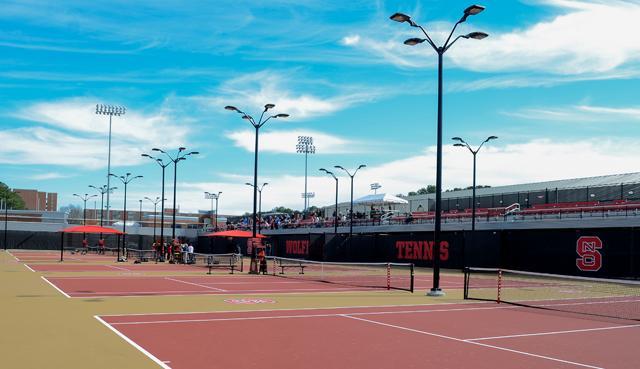If you asked men’s tennis head coach Jon Choboy to describe the team’s previous outdoor tennis facility, he would use one simple word – terrible.
“We didn’t have [a stadium],” Choboy said. “What we had was six courts with a fence around it and cracks all over the courts. It was just terrible. It was worse than high school facilities.”
“It wasn’t something that I had to convince people [about], that we had a poor facility,” Choboy continued. “It was well- known.”
Although the journey has been a long process, Choboy has had a vision for the team for many years. He pushed the issue with administration, making the case that tennis is an outdoor sport and his team deserved better than “the worst facility in the country.”
Following a 2007 season that saw an Elite Eight run for the team, Choboy asked then Athletic Director Lee Fowler for a few minutes of his time.
“I said, ‘Lee, we’ve done some good things here,'” Choboy said. “‘We’ve put up some good numbers and put together a couple of good teams here, and I can’t do this by myself. I need your help. The men’s and women’s programs need a facility.’ He said right away, ‘I know you do. We’ve got some money coming through for a couple different avenues here, and on that list we’re going to build a tennis stadium. I understand what you’re saying. I agree.'”
That was the year and moment that got the ball rolling. However, the pursuit of the dream began two years earlier for Choboy , along with a young man named David Rozek .
Rozek , a design major and member of Choboy’s tennis team, was asked to perform an immense favor by his coach – come up with a design for an outdoor stadium.
“I was thinking maybe he’d draw up a blueprint or something,” Choboy said. “If he put something on a piece of paper, it could be something we could have. Then he came up with the idea. He said, ‘Coach, if you give me a little bit of time, I’ll build a 3-D model of the stadium you’re talking about. I’ll design it and build it to scale.'”
Six months later, Rozek , who was only a sophomore at the time, had a model about the size of an office desk completed to scale.
“I felt like it was a great opportunity to work on something like that,” Rozek said. “I just wanted to do a good job.”
Choboy was beyond impressed with the work and detail put into Rozek’s model.
“It was beautiful,” Choboy said. “If we could have this, it would be awesome; that would be cool.”
When it came time to interview the designers, Rozek’s original model was presented as a base to work with. Although the designers flipped the stadium around and made some improvements, much of Rozek’s design was incorporated into the final project.
Stadium construction began in February 2011 and took about eight months to complete. Rozek has had a few chances to check the stadium out himself since the opening and is pleased with the way it turned out.
“I think it’s incredibly impressive and it’s one of the best venues to play in that I have ever seen,” Rozek said. “It turned out way better than I thought it was going to be after designing it. It’s a world-class stadium.”
Choboy has used the stadium as a recruiting tool since the early design stages and is happy to see it come to reality instead of a simple dream, not only for himself, but for players and recruits as well.
“There’s a period of time when you take a recruit out there and you don’t actually have to talk for a few minutes,” Choboy said. “You just let them walk around and you let them judge for themselves. This one speaks for itself and you can let it do a little bit of the talking for you.”








